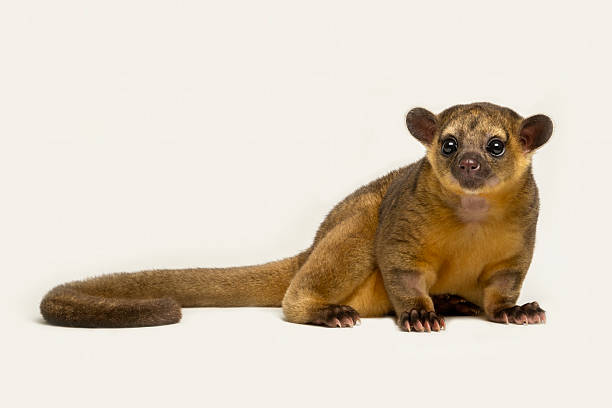Kinkajous, often called “honey bear animals” for their sweet-toothed nature and bear-like appearance, are nocturnal mammals with a suite of fascinating traits. Although frequently mistaken for monkeys due to their agility in the treetops, they are, in fact, closer kin to raccoons. Members of the Procyonidae family, these arboreal creatures possess a unique blend of characteristics that allow them to thrive in dense tropical forests.
Table of Contents
Scientific Classification
- Kingdom: Animalia
- Phylum: Chordata
- Class: Mammalia
- Order: Carnivora
- Family: Procyonidae
- Genus: Potos
- Species: Potos flavus
As part of the Procyonidae family, kinkajous are raccoon relatives, sharing ancestry with animals like coatis, olingos, and ringtails. This classification places them firmly among the procyonids, a small but diverse family of omnivorous mammals.
Description / Physical Description
Kinkajous boast a captivating blend of soft, velvety fur and wide, round eyes that gleam in the dark. Their coats are usually golden-brown, with subtle variations ranging from tawny beige to cinnamon.
These animals average 40–60 cm (16–24 inches) in body length, with a prehensile tail nearly as long as their torso, measuring 40–55 cm (16–22 inches). Their tail functions like a fifth limb—curling around branches for support or balance while they forage.
They weigh between 1.4 to 4.6 kg (3 to 10 lbs), exhibiting a compact, muscular frame well-adapted for climbing. With a short snout and an elongated tongue extending up to 13 cm (5 inches), they are ideally equipped for extracting nectar and honey—giving rise to the nickname “honey bear animal.”
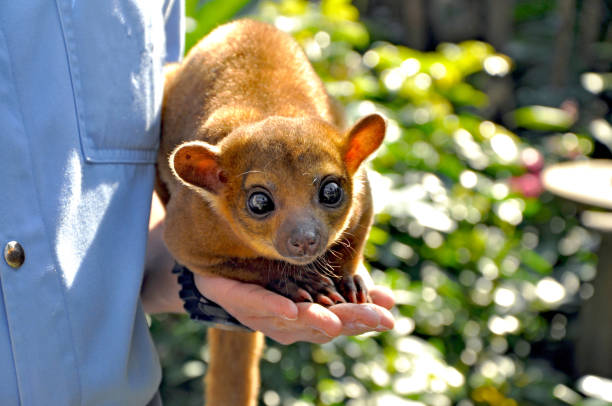
Range & Distribution
Where do kinkajous live? Their distribution stretches from southern Mexico down through Central America into northern regions of South America, including Brazil, Bolivia, Peru, and parts of Ecuador.
Kinkajous prefer the vast, uninterrupted stretches of tropical and subtropical rainforests. However, they are also found in secondary forests and areas of regrowth, demonstrating a degree of ecological flexibility.
Habitat
The kinkajou’s realm lies high in the treetops of the rainforest canopy. Arboreal by nature, these mammals rarely descend to the forest floor. They nest in tree hollows and spend most of their time traveling through dense foliage, sometimes traversing entire territories without touching the ground.
Humidity is essential for their survival. These animals rely on the complex structure of the forest to find shelter, food, and social interaction.

Diet
Despite being classified in the order Carnivora, kinkajous are primarily frugivorous. Their diet consists mostly of fruit, particularly figs. However, they are opportunistic feeders and also consume:
- Nectar
- Honey
- Flower blossoms
- Small vertebrates (like lizards and birds)
- Insects and eggs
Their long, narrow tongue allows them to access deep floral tubes or reach into tight spaces within tree bark and crevices to lap up honey or nectar.
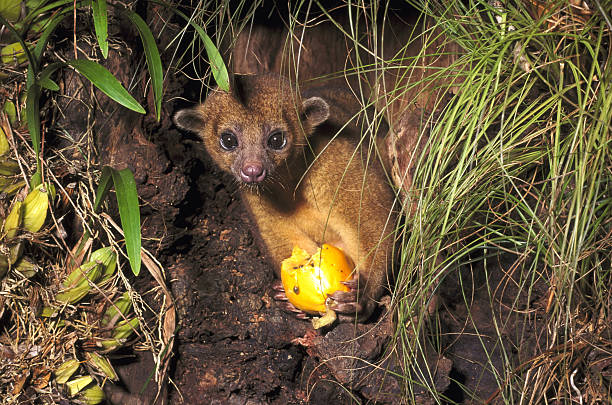
Behaviour / Lifestyle
Kinkajous are nocturnal and solitary for the most part, although small familial groups sometimes form, particularly among mothers and their young.
These animals are extraordinarily agile and silent in their movements. They rely on olfactory cues and vocalizations—grunts, hisses, and high-pitched squeaks—to communicate.
A defining behavior is their tendency to mark their territory using scent glands located at the corner of their mouth, throat, and abdomen. Social grooming is observed in some groups, especially among related individuals.
Lifespan
In the wild, kinkajous live up to 20 years, although average lifespans are slightly shorter due to predation and environmental pressures. In captivity, they can surpass 25 years, benefiting from veterinary care and a stable food supply.
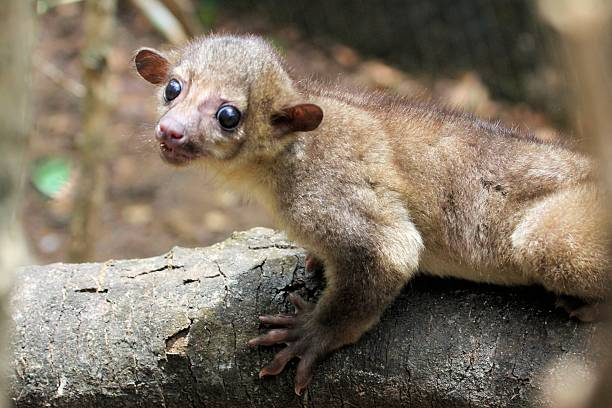
Adaptations
Kinkajous exhibit a suite of adaptations that suit their canopy-dwelling lifestyle:
- Prehensile Tail: Offers exceptional grip and balance.
- Flexible Ankles: Capable of rotating their feet 180 degrees, enabling them to descend headfirst like squirrels.
- Nocturnal Vision: Large eyes with a reflective layer (tapetum lucidum) enhance night vision.
- Elongated Tongue: Reaches nectar and honey otherwise inaccessible.
- Scent Marking Glands: Aid in communication and territorial boundaries.
These features reflect a strong evolutionary trajectory toward arboreal specialization.
Mating & Reproduction / Reproduction & Lifecycle
Kinkajous do not have a fixed breeding season, although births peak during the wet season when food is abundant.
- Gestation: Approximately 112 to 118 days
- Litter Size: Typically one, occasionally two
- Weaning: At 8 to 10 weeks
- Independence: Reached at around 3 months
- Sexual Maturity: Around 2 years of age
Mother kinkajous are the primary caregivers. The young remain close to the mother’s body for warmth and protection, often hidden in leafy nests within tree cavities.
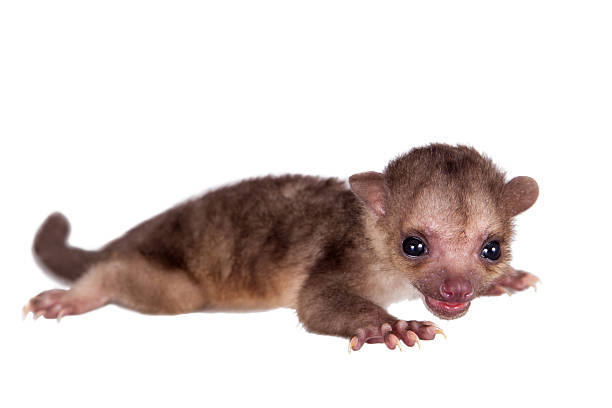
Predators
Natural predators include:
- Ocelots
- Jaguars
- Boa constrictors
- Harpy eagles
- Humans (due to pet trade and habitat destruction)
Despite their arboreal habitat, kinkajous must remain vigilant, especially during feeding or nesting.
Conservation Status
The IUCN lists Potos flavus as Least Concern, yet kinkajous face growing threats:
- Deforestation: Particularly in Central America, reducing viable habitat.
- Pet Trade: An increasing number of kinkajous are captured for the exotic pet market.
- Road Mortality: Expanding human infrastructure poses dangers when kinkajous traverse forest gaps.
Although not yet endangered, proactive conservation measures are essential to secure their future.
Interesting Facts
- Despite their name, kinkajous are not bears.
- They are one of the few carnivores with a fully prehensile tail.
- Kinkajous can turn their feet backward to run either direction across branches.
- Their tongues are not just long—they are muscular and highly dexterous.
- In the wild, they can travel up to 3 km in a single night while foraging.
- Kinkajous have a relatively slow metabolism and long digestive tracts, helping to extract maximum nutrition from fruit.
As Pets
The kinkajou pet trend has grown in some parts of the world, but keeping kinkajous as pets poses numerous challenges.
- Nocturnal Behavior: They are active and vocal at night.
- High Energy Needs: Require complex climbing spaces and mental stimulation.
- Dietary Complexity: Must have access to specific fruits, nectar, and protein.
- Aggression: Even tamed individuals may bite or become territorial.
- Legality: In many regions, owning a kinkajou is restricted or illegal.
Though adorable, kinkajous are not domesticated. Potential pet owners should weigh ethical and ecological considerations before pursuing kinkajous as pets.
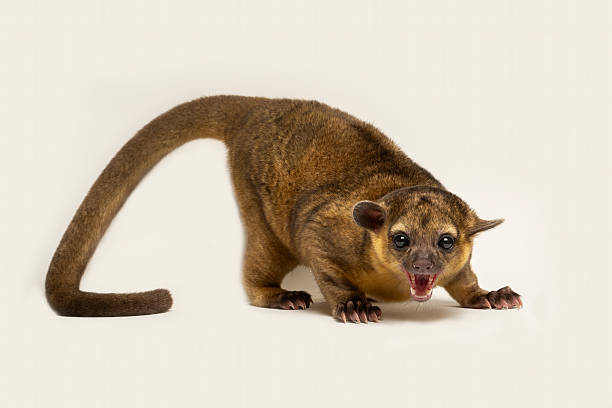
Classification of Species
The kinkajou is the sole species in the genus Potos, making it monotypic within its taxonomic bracket. However, variation across its range has prompted discussions about potential subspecies or geographic races based on morphology and coloration.
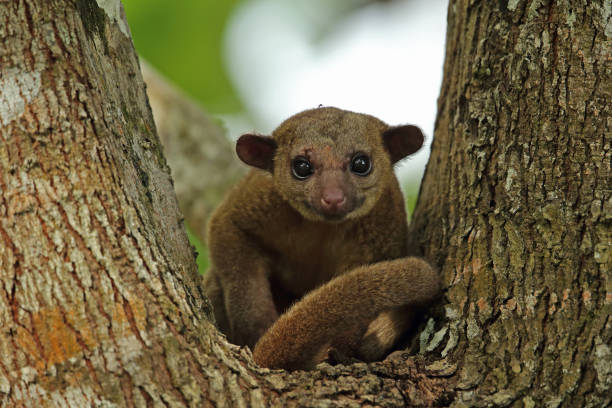
Subspecies
Kinkajous exhibit subtle geographic variation across their wide range, and taxonomists recognize seven subspecies of Potos flavus. Though common names are not universally standardized, some regional descriptors are used to differentiate them. These subspecies are primarily distinguished by size, coat coloration, and minor morphological traits.
- Northern Kinkajou (Potos flavus flavus)
The nominal subspecies found in the northernmost part of the range, including Mexico and northern Central America. - Chiriqui Kinkajou (Potos flavus chiriquensis)
Native to Panama and Costa Rica, this subspecies tends to have slightly darker fur and smaller ears. - Chapada Kinkajou (Potos flavus chapadensis)
Found in central Brazil, particularly in the cerrado and transitional forests. - Large-eared Kinkajou (Potos flavus megalotus)
As the name suggests, it has proportionately larger ears. Native to parts of western Amazonia. - Mérida Kinkajou (Potos flavus meridensis)
Restricted to the Venezuelan Andes, particularly around the Mérida region. Often has thicker fur to adapt to cooler climates. - Modest Kinkajou (Potos flavus modestus)
A less studied subspecies with a subdued coat color, found in southern Colombia and northern Ecuador. - Nocturnal Kinkajou (Potos flavus nocturnus)
Known from regions of Peru and adjacent areas, with deep golden to reddish fur and highly nocturnal tendencies noted in field studies.
While the distinctions are subtle and sometimes overlap, these subspecies collectively reflect the ecological plasticity of kinkajous across diverse neotropical environments. Further molecular research may redefine or consolidate these subspecies in the future.

